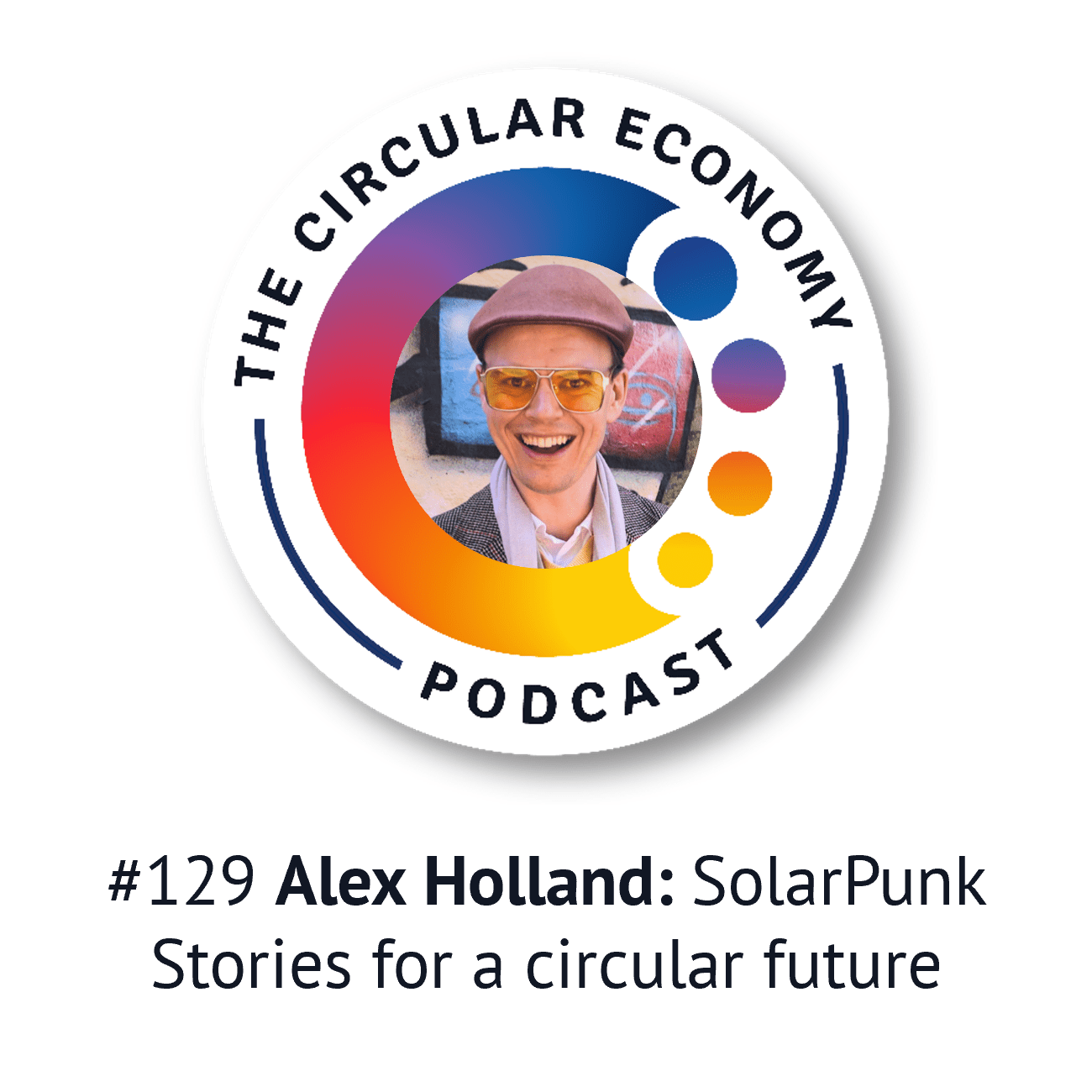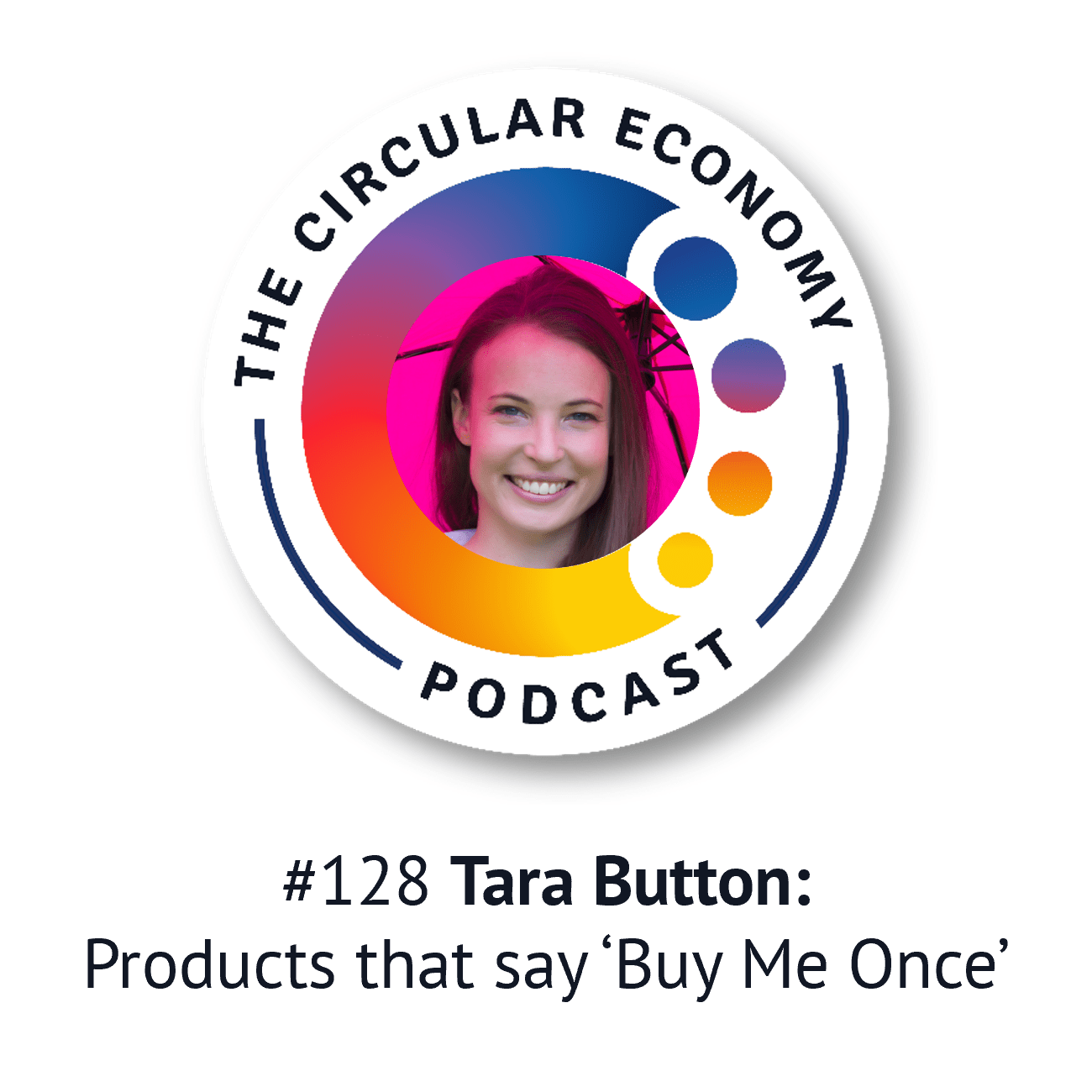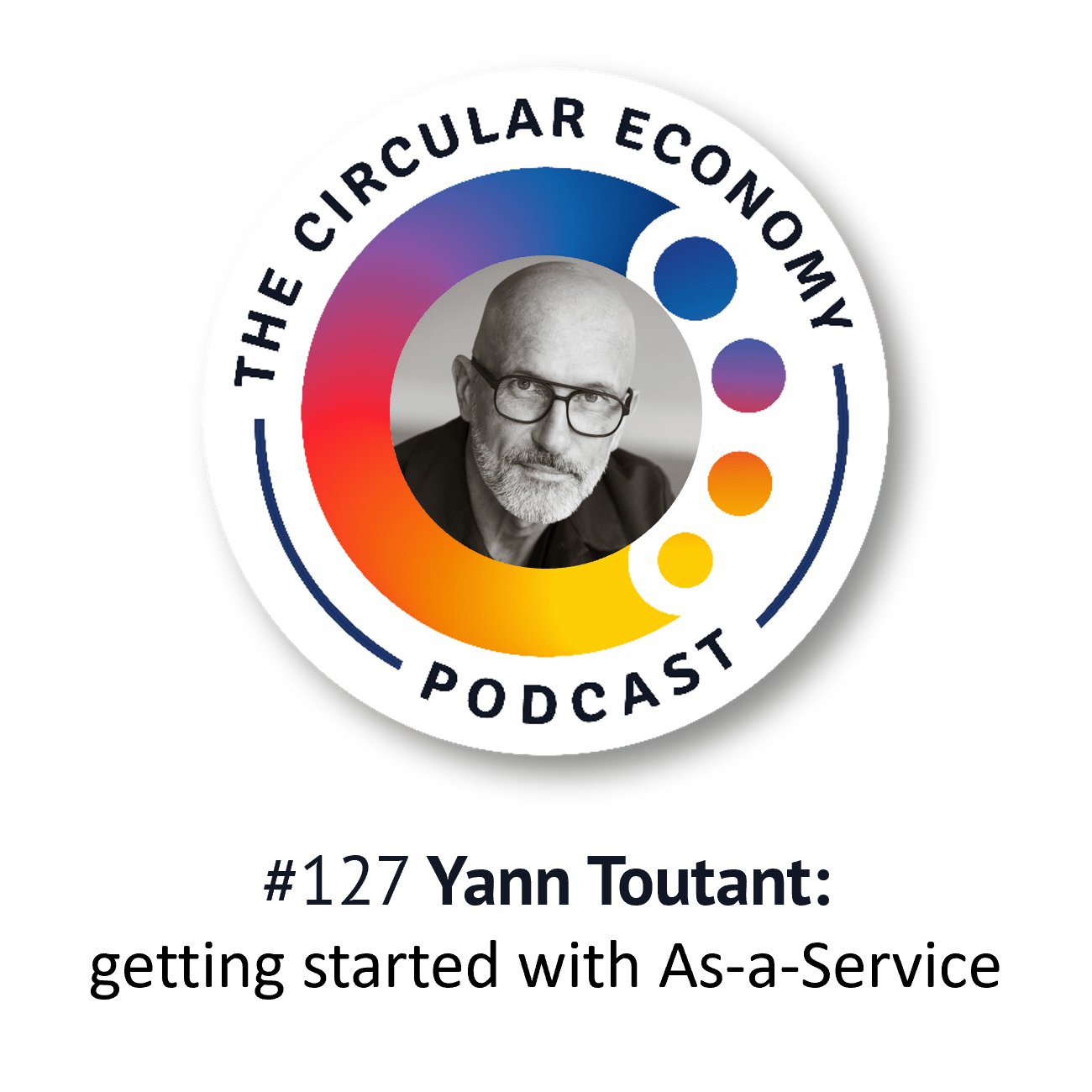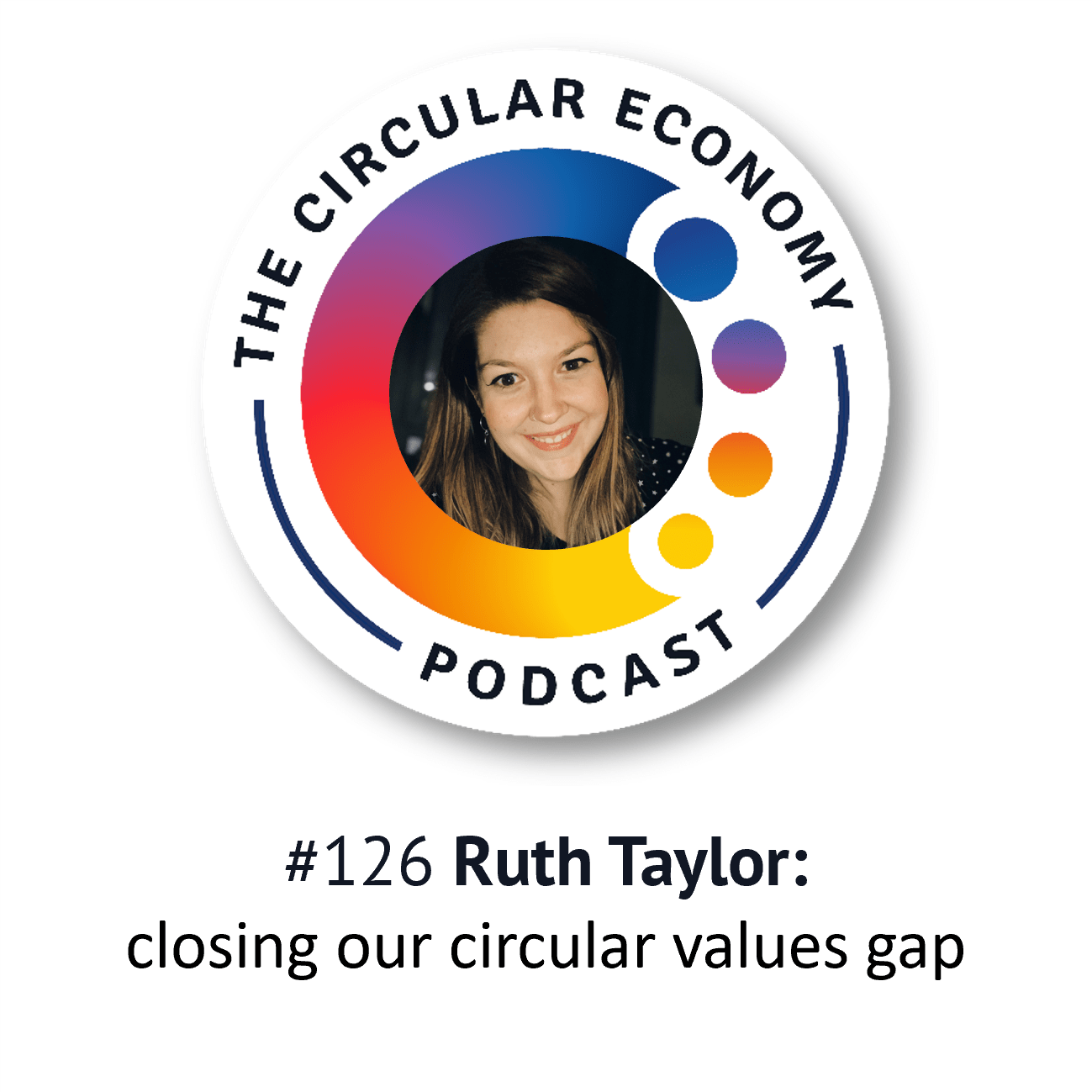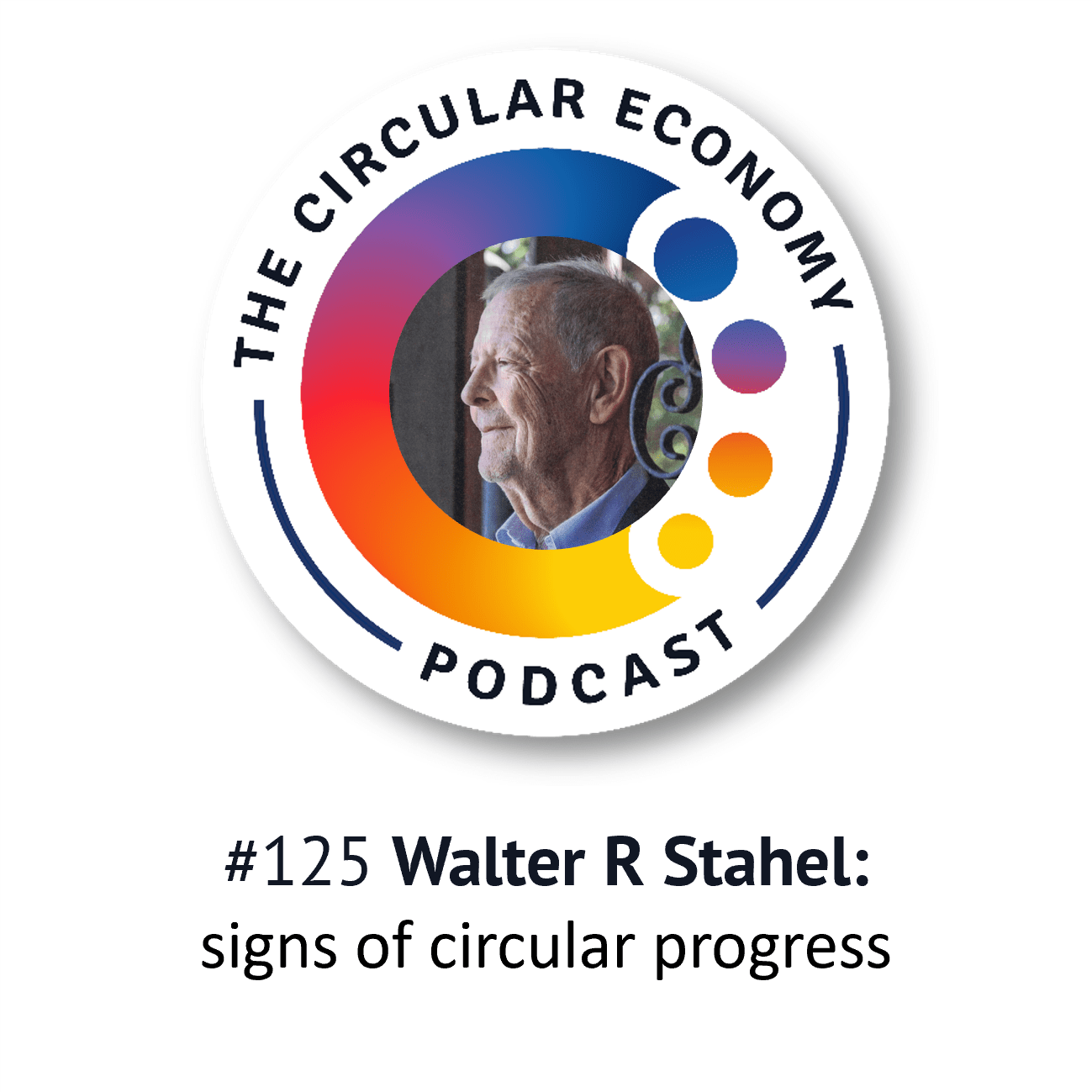Podcast: Play in new window | Download
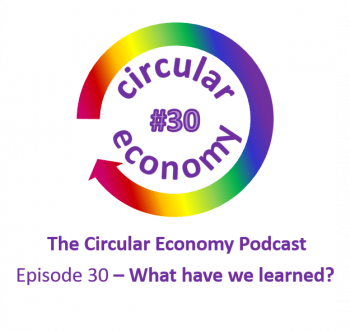 It’s EPISODE 30, and we’re reflecting on the last nine episodes, drawing out some themes we can learn from. Plus, there is a further conversation with Geoff van Sonsbeeck of womenswear brand Baukjen, in which we discuss packaging.
It’s EPISODE 30, and we’re reflecting on the last nine episodes, drawing out some themes we can learn from. Plus, there is a further conversation with Geoff van Sonsbeeck of womenswear brand Baukjen, in which we discuss packaging.
The wonders of online communication mean we’ve been to the United States, Jordan, Uganda, Canada and Ghana in the last nine episodes. We’ve talked to a start-up looking for funding, two social enterprises, two charities, a community cooperative, and several businesses that have been growing for 15-20 years.
If we look at the circular economy strategies of these organisations: five are helping to ‘Close the Loop and Regenerate’, two are ‘Slowing the Flow’ of materials through more durable, circular designs, and two are ‘Intensifying the Flow’ through sharing services.
To read a summary of those circular economy strategies with a simple diagram, go to the Resources section of the Rethink Global website and read our article: What is the circular economy
We’ll also look at how these different organisations are creating value for different groups – for their customers, suppliers, employees, communities – and for our planet.
Podcast host Catherine Weetman is a circular economy business advisor, workshop facilitator, speaker and writer. Her award-winning book, includes lots of practical examples and tips on getting started. Catherine founded Rethink Global in 2013, to help businesses use circular, sustainable approaches to build a better business (and a better world).
Stay in touch for free insights and updates…
Read on for a summary of the podcast and links to the people, organisations and other resources we mention.
You can subscribe to the podcast series on iTunes, Google Podcasts, PlayerFM, Spotify, TuneIn, or search for “circular economy” in your favourite podcast app. Stay in touch to get free insights and updates, direct to your inbox…
Links we mention in the episode:
- Book: https://www.rethinkglobal.info/circular-economy-handbook/
- Article: What is the circular economy https://www.rethinkglobal.info/what-is-the-circular-economy/
- Catherine’s blog: Why ‘semi-circular’ strategies are a sustainable step forward https://www.rethinkglobal.info/semi-circular-strategies/
- Catherine’s blog: Fashion: from fast and forgettable to slow and sustainable – why purpose-driven brands like Baukjen and Isabella Oliver are choosing circular strategies https://www.rethinkglobal.info/fast-forgettable-to-slow-sustainable-circular-fashion/
- Catherine’s blog on social entrepreneurs in Africa – Transforming plastic waste into social value https://www.rethinkglobal.info/plastic-waste-social-value-africa/
- Close the Loop closetheloopusa.com
- Bassam Huneidi – website https://www.bassamhuneidi.com/ and The Argeileh Project https://www.bassamhuneidi.com/tap-1
- Bassam Huneidi on LinkedIn https://www.linkedin.com/in/bassamhuneidi/
- EcoBrixs https://www.ecobrixs.org/
- Circular Computing https://circularcomputing.com
- Circular Computing on LinkedIn https://www.linkedin.com/company/circular-computing/ Facebook https://www.facebook.com/CircularIT/ Twitter https://twitter.com/CircularIT YouTube https://www.youtube.com/channel/UCTMeej5BHhcgxeyPXar_Vww
- Steve Haskew on LinkedIn https://www.linkedin.com/in/stephen-haskew-4732731a/
- Geoff van Sonsbeeck on LinkedIn https://www.linkedin.com/in/geoffvansonsbeeck/
- Baukjen https://www.baukjen.com/
- Isabella Oliver https://www.isabellaoliver.com/
- Social media https://www.facebook.com/Baukjen/ https://www.facebook.com/IsabellaOliverMaternity/
- Lil Packaging Lilpackaging.com
- B Corporation https://bcorporation.net/
- Katie Briggs on LinkedIn https://www.linkedin.com/in/katie-briggs-83aaa77a/
- The Textile Review https://www.thetextilereview.com/
- The Textile Review on Instagram @textile.review
- Chris Hellawell on LinkedIn https://www.linkedin.com/in/chris-hellawell-7284475a/
- Edinburgh Tool Library website https://edinburghtoollibrary.org.uk/
- Chris Diplock: Info@thethingery.com
- The Thingery http://thethingery.com/
- Mabel Suglo on Facebook, Instagram and LinkedIn with Mabel Suglo.
- Also on twitter @SugloMabel1
- Dignified Wear on Instagram https://www.instagram.com/dignifiedwear/
- Dignified Wear on Facebook https://web.facebook.com/DignifiedWear/
- ING International Survey – consumer attitudes towards the circular economy (November 2019)
Transcript
It’s EPISODE 30, and I’m going to reflect on the last 9 episodes, drawing out some themes we can learn from. There’s also a further conversation with Geoff van Sonsbeeck of womenswear brand Baukjen, where we discuss packaging.
The wonders of online communication mean we’ve been to the United States, Jordan, Uganda, Canada and Ghana in the last nine episodes. We’ve talked to a start-up looking for funding, two social enterprises, two charities, a community cooperative, and several businesses that have been growing for 15-20 years.
If we look at the circular economy strategies of these organisations: five are helping to ‘Close the Loop and Regenerate’, two are ‘Slowing the Flow’ of materials through more durable, circular designs, and two are ‘Intensifying the Flow’ through sharing services.
To read a summary of those circular economy strategies with a simple diagram, go to the Resources section of the Rethink Global website and read our article: What is the circular economy
We’ll also look at how these different organisations are creating value for different groups – for their customers, suppliers, employees, communities – and for our planet.
In Episode 21, we heard from a company called Close the Loop, which started in Australia in 2001, expanded into the US in 2007 and then into Europe in 2016. In my conversation with Tom Ogonek, we hear how Close the Loop has evolved as people have become more aware of the benefits of circular economy approaches.
Close the Loop provides collection, recovery and reuse programs for a range of products, starting out with printer cartridges and now expanding into other products, including cosmetics.
What began as a way to collect print cartridges for major printer brands, so they didn’t end up being refilled and sold as cheaper alternatives, is now a thriving business using materials science to develop ways of reusing more and more of the metals, plastics and even inks in those printer consumables.
Tom Ogonek I believe the manufacturers started doing this as a defensive to the remanufacturers. But since then it is developed more into how do we get value out of these. It’s, it’s expected from customers. There, it, it’s a bad PR to have cartridges sitting in landfills and, and people taking videos of that. So it, it’s become more about, Hey, we have sustainability goals, we want to engage in the circular economy. How do we keep getting more and more value out of these return programs? And that’s what Close the Loop does – we try to mind the value, show them where the value it is. It’s not just a marketing ploy but that it’s about value-added processes to engage in the circular economy.
Catherine
Close the Loop is building its knowledge of what makes a good circular design: which features help its manufacturing clients to efficiently and effectively recover as much value as possible at the end of the product’s use? That knowledge means CTL can then help the design teams of those OEMs.
Tom Ogonek What design changes could be made? That’s something that, that we have been in discussions with since we’ve started going through the recycling process. How do you make this easier or make it easier to recover? Because at the end of the day, you want to be able to recover this, this product and not have it hit landfill, which is where our commitment waste energy we use as a last resort. So we try to minimize that as much as possible because once you, once you burn that, there’s nothing left. So it’s really about how do we keep plastic in plastic? How do we keep metal and metal, etc.
Circular Computing
In Episode 24, we learned about another well-established business with a strategy to ‘close the loop’. Circular Computing has been remanufacturing high-quality top-brand laptops, including Dell, HP and Lenovo, since the 1990s. It now provides laptops to education, public sector and even direct to consumers.
Steve Haskew told us how every machine goes through a 100+ point-check, any worn components are replaced and selected components are upgraded to give them a performance boost. The laptops are certified carbon-neutral, with performance tested as providing 97 per cent compared to a new model.
The company now has over 250 staff and remanufacturing capacity of up to 10,000 units each month. As I mentioned in the last Circular Insights, HP began promoting Circular Computing’s carbon-neutral remanufactured Hewlett-Packard (HP) laptops to consumers alongside the brand-new HP model. HP is responding to the extra demand for laptops as more people work from home, and children are home-schooling.
Steve explained the difference between proper remanufacturing and the unregulated second-use markets like e-Bay, where you might find laptops marked as remanufactured or refurbished, but you are taking the risk on quality, reliability and so on.
Steve Haskew talked about “semi-circular strategies” as a step in the right direction, and I explored this semi-circular concept in a follow-up blog: Why ‘semi-circular’ strategies are a sustainable step forward.
Steve also explained how Circular Computing has developed different value propositions for each of the people involved in the client’s decision process. The IT manager, the CEO, the person responsible for waste disposal and the sustainability director all have slightly different objectives, and Circular Computing helps each of them get comfortable with the idea of using remanufactured equipment by creating a business case for their specific needs.
In the research for the 2nd edition of my CE Handbook, looking at what companies like Apple are doing, I think major brands are starting to see that the linear model isn’t working for them. For phones, tablets, laptops and lots of other products, to get people to upgrade to a new model means it has to look better, and have sufficient improvements in features and performance. The pressure to sell more, and to create a new model to do that means lots of investment in R&D. When the new model is launched, it needs massive marketing spend, and probably means writing off valuable stock of the old models.
And, as I’ve mentioned before, using other tactics like software ‘upgrades’ that actually downgrade the performance of the old model, can quickly destroy brand trust.
A survey by ING in 2019, across 13 countries, found 60% of people expect to repair products instead of discarding them, in the next three years
Once people realise there aren’t many benefits to paying for the latest model, and that some companies are designing products that can be repaired, upgraded, and remade, then ‘new’ becomes less attractive. Realising that remanufactured products perform almost as well as new ones, but have a much lower environmental footprint, and cost less, gives people a win-win option.
Baukjen – Geoff van Sonsbeeck talks about packaging
For Ep 25, just before the lockdown, I was in London, and visited Geoff Van Sonsbeeck, the founder and CEO of 2 clothing brands. Geoff and his wife set-up maternity clothing brand Isabella Oliver back in 2003, to solve the problem of how to find high-quality, beautiful maternity wear. They sell small capsule collections of well-designed clothes that will last for years. Customers loved what they were doing and in 2012, Geoff expanded into contemporary womenswear with the non-maternity brand ‘Baukjen’.
Both brands focus on environmentally, ethically and socially conscious style for a sustainable future. Baukjen is also working through the process of certification as a B Corp.
We talked about how the two brands are building on their durable and timeless design ethos and evolving a range of circular practices. These include takeback schemes, resale, and rental. Baukjen is also switching to more sustainable fabrics – even moving away from organic cotton.
After the interview, we got talking about Baukjen’s approach to packaging – have a listen.
~
Catherine Weetman So we have a lot of consumers these days wanting to do the right thing for the environment for the climate and biodiversity emergency. And people are starting to focus quite a lot on packaging because it’s something they feel they can actively do something about whether that’s reducing or making sure it’s recycled, or trying to find a zero package packaging option. What are you doing to try and help people reduce their footprint?
Geoff van Sonsbeeck we take it very serious, because packaging is integral to the business we have it has an intensity, but it can also be designed for good but the shocking stat is that 50% of the plastic waste out there globally, is actually coming from plastic packaging is unacceptable. And it’s often you know, one time use it’s a really hard situation. So the long short is that we since 2018 are 100% plastic free and all the packaging to the customer And we’ve done this in an interesting way we worked with a company called Lil Packaging [https://www.lilpackaging.com/], who were very innovative and pushing the boundaries and coming up with packaging that is again functional good looking, but also made from 100% recycled materials, 100% plastic free, using natural inks in the printer technique. It is completely recyclable and the box or the paperback we use two different things also biodegradable. Now, this is all to me natural and I really don’t understand why the sector doesn’t do this at large. Hence my Lil Packaging kind of plug here please or go there and pick it up. But we’ve also done a bit more on it and we thought how do we get the customer to to recognise this and, and what we’ve done on our packaging, putting it quite central when you open the box on the outside of our paper envelope (which we increasingly use or recycled) is to put a big barcode, a QR code. And we basically ask the customer, point your mobile camera to the barcode, you don’t need to click, you don’t need to scan, point it to discover how I’m made, why I’m so friendly, what to do with me if you don’t need it. And this is a unique opportunity for us to get customers on our journey to see what our ambition has been and how we over the last years, kept making changes big and large changes towards that objective. And there were anecdotal things in there. Did you know that you know, we went to what they call a worm farm to see how long does it take for this box to biodegrade if you put them in the ground, and what do you need to do? And we can just give all of that information to the customer. So it’s not just the journey was anecdotal on colour storytelling, but it’s also about practical advice, what to do, and we just adopting the idea that you know, there’s so many different icons and things out there. It’s really confusing?
Then we said, should we use this platform too, to just try to make sense in layman language to people what these icons mean, which, you know, raises questions like, “but hang on, we’re a fashion company, we’re also a bit of a disrupter, are we tech? What are we? Are we now also packaging advisors?” So part of our thinking is we need experts to help do that for us. But we have a unique opportunity to teach customers and in doing so, inevitably, change behaviour.
Catherine Weetman Yes, I think people will really be enthused by that. And it’s surprising that more companies aren’t doing that and that there aren’t more collaborations, enabling that to happen. There was a programme I was watching This Week on Channel five all about recycling. And people generally, you know, didn’t understand the symbols and there was one symbol that was used on a few packages that was just meaningless. And yet the visual image of the symbol led people to think it must be recyclable, but actually it was a meaningless so…
Geoff van Sonsbeeck very dangerous.
Catherine Weetman Yeah. And again, when people find that out, it kind of undermines their trust in the brand that’s used that symbol.
Geoff van Sonsbeeck I totally agree. But, you know, ironically biodegradable is actually a difficult category. Yeah. And, and if biodegradable goes in recycling, it can really contaminate and cause trouble, which on occasions may lead you to say better not biodegradable. You have to follow also what the large part of the customers actually we’ll do with that. Yeah, so sometimes not being the best may be better for the world.
Catherine Weetman Yes, I think finding the easiest route to get it back into the system. And as you say, if it’s biodegradable or compostable, but it’s not likely to go into a compostable route, then you’re better off using a, you know, readily recyclable plastic and at least that keeps something in the loop.
~
I was impressed by the way Baukjen continually evolves its approaches, always looking at how it can be more responsible, more circular, and make long-lasting positive change. There wasn’t enough time in the podcast to cover everything, so I wrote a follow-up blog: Fashion: from fast and forgettable to slow and sustainable – why purpose-driven brands like Baukjen and Isabella Oliver are choosing circular strategies
The Argeileh Project to the Edinburgh Tool Libary
Every organisation covered in the last nine episodes is providing multiple forms of value – for customers, employees, suppliers, their local communities – and for our planet.
In Episode 22, we heard from Bassam Huneidi in Jordan. Bassam was setting up a circular economy system for Argeilehs, which are an important part of café-culture, allowing people to share tobacco-smoking. Bassam’s Argeileh Project offers better value for money for the café owners, as well as a healthier experience for café customers and employees. By providing a circular alternative to single-use vapes, it has the potential to replace 440 million single-use pieces of plastic across the middle-East, every year.
In the next episode, we heard from Andy Bownds, the founder of EcoBrixs in Uganda. EcoBrixs enables communities to earn money by collecting waste plastic to be converted into bricks and pavers in a process that combines the plastic with sand. Across much of Africa, plastic waste is a massive issue for wildlife, livestock and human health. EcoBrixs solves a local problem and, by providing flexible jobs, enables disabled and disadvantaged people to earn money.
Moving onto Ep 26, and we talked to Katie Briggs. Katie set up The Textile Review to close the loop on fabric from the events sector, helping buyers and sellers reduce cost and impact. She provides her customers with information on the environmental impact of their more sustainable choices, and with transparency, by tracking where products come from and where they go to.
By doing this, Katie makes it easy for her customers to ‘tell the story’ about their sustainability, ethical and circular improvements.
The next couple of episodes were about ‘Library of Things’ initiatives. First, in Ep 27, we heard about the Edinburgh Tool Library, from Chris Hellawell. This is a charity, which provides a wide range of community and education programmes, as well as the tool library itself. One of the projects is funded by the Volant Trust, supporting women who’ve either been victims of domestic abuse, are long-term unemployed, or lack confidence. Small groups work with female woodwork tutors over several weeks, first building something for themselves, then working together to build something for the community.
Chris Hellawell And I think what’s particularly powerful about that is when it’s people who have perhaps been told that their value is less than it really is, and it’s a great way of them thinking, “you know what, I can do this and I don’t need anybody’s permission.” And that’s something that I’m incredibly proud of. And, you know, we’ve been doing that for two or three groups now and we’ve got another – when this is all finished with Coronavirus – we’ve got about seven or eight groups we’ll be working with, all lined up to take that on. And then we also have a fantastic – one of the amazing things about the Tool Library is that we create so many opportunities for volunteers. So there’s the delivery of the services, the librarians, the workshop volunteers. And but also we, we recognise that, you know, volunteering every, every Wednesday night or every Saturday afternoon isn’t necessarily fit with everybody’s sort of lifestyle or balance of work and downtime. So we have usually around six projects a year, where other community groups, charities, schools, come and suggest an idea that our volunteers can support them with. And then the volunteers, we facilitate the volunteers and project managing that and developing, you know, designs, plans, sourcing materials, working out what tools they need, making sure all the health and safety and you know, the kind of risk assessments are all ready for that.
Chris Hellawell But then it’s still led by the volunteers with support from staff and, and then it’s usually over the course of a weekend or a couple of weekends. And there’ll be between 10 and 20-30 people and going out volunteering, building things for we’ve, we built a small vegetable shop and a kind of potting shed. And we’ve built the one we’re working on when this was all stopped [for Coronavirus] with rebuilding a pirate ship that was torched by some arsonists at a primary school. So we’ve been ripping all that out and rebuilding it, and we’ve done outdoor kitchens for primary schools or mud kitchens, sandpits, you know, all that kind of stuff. And, and that’s really great because it connects us with other groups that are, you know, have a similar sensibility. We think that you know, that community work and doing things together rather than having them done for them is more important. I think I think particularly what I really like about the school’s projects is and like it’s, you know, it’s very rewarding, seeing good getting pictures from kids of them playing in the sandpit. But I think what’s more important is those kids understand that all of that material was reused.
Workshop sessions help bring people together, and Chris gives us an example of how working together helps spark conversations and connections.
Chris Hellawell there was one particular day I could think of and I went into the workshop, and there were around 20 students – an Italian, a Spaniard three very local – like born across the road ‘Leithers’ [from Leith in Edinburgh] – and a Syrian refugee. So we have an arrangement with the council. So we give free memberships to ??? from Syria so and they were all we sort of stop everybody halfway through and make everybody drink tea and just to kind of build some conversation and talk about projects and things. And I was just like this is what we want to bottle, this is the essence of what it is, because you’ve got people from all over the world. And the thing that’s bringing them together is what they’re making and doing things with the hands. It’s got nothing to do with, you know where you’re from, who you are, what my assumptions are about your background. It’s about all “what are you making? Tell me about that?” And I think that’s the real power of a community workshop like this.
The Thingery and Dignified Wear
We heard about a different approach to Libraries of Things in Episode 28, when we spoke to Chris Diplock in Vancouver. Chris told us about The Thingery, a kind of ‘library of things’ in a box – a shipping container. It’s solar-powered, uses computers and barcodes to manage the lending process, and secure access, so members of the cooperative can access it at convenient times. Chris wants to expand the Thingery concept around the world – have a look at the Thingery website to find out more.
Finally, in Ep 29, we spoke to the amazing Mabel Suglo, who set up Dignified Wear, a social enterprise in Ghana making shoes, bags and other products from waste materials like tyres. Mabel was inspired by her grandma, who had leprosy and had to struggle with the physical challenges of that, with the difficulty of finding paid work, and with the social stigma of disability which exists across many parts of the world.
Dignified Wear is a social enterprise providing training and paid employment for disabled and disadvantaged people, creates value from problematic waste, and concentrates on making products with traditional Ghanian styles and skills, helping create a healthy export market and bring extra money into the community.
I’m looking forward to talking to more people making the circular economy happen in future episodes. I’m keen to find more businesses and social enterprises outside the UK, and in developing economies. If you know of a good example, please get in touch – email us via podcast@rethinkglobal.info
Want to find out more about the circular economy?
If you’d like to learn more about the circular economy and how it could help your business, why not listen to Episode 1, or read our guide: What is the Circular Economy?
To go deeper, you could buy Catherine’s book, A Circular Economy Handbook for Business and Supply Chains This comprehensive guide uses a bottom-up, practical approach. It includes lots of real examples from around the world, to help you really ‘get’ the circular economy. Even better, you’ll be inspired with ideas to make your own business more competitive, resilient and sustainable.
Please let us know what you think of the podcast – and we’d love it if you could leave us a review on iTunes, or wherever you find your podcasts. Or send us a Tweet: @Rethink _Global.
Podcast music
Thanks to Belinda O’Hooley and Heidi Tidow, otherwise known as the brilliant, inventive and generous folk duo, O’Hooley & Tidow for allowing me to use the instrumentals from the live version of Summat’s Brewin’ as music for the podcast. You can find the whole track (inspired by the Copper Family song “Oh Good Ale”) on their album, also called Summat’s Brewin’. Or, follow them on Twitter.
